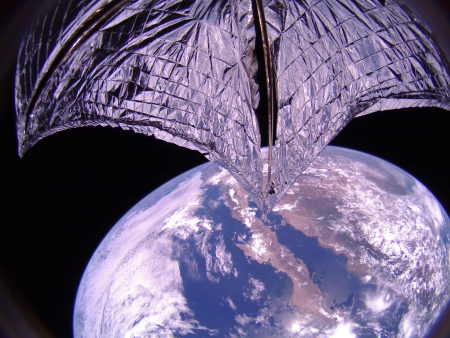LightSail-2 completes three-plus year mission, burning up in atmosphere

LightSail-2, shortly after deployment in 2019.
LightSail-2, an experimental solar sail built by the Planetary Society, finally ended its mission this week, with the test sail burning up in the atmosphere upon re-entry.
LightSail 2 was launched aboard a SpaceX Falcon Heavy rocket in June 2019, settling into an initial orbit at an altitude of around 720 km (450 miles). At that height, the Earth’s atmosphere is still thick enough to create drag, which would threaten to eventually pull the spacecraft down.
But that’s where the plucky little satellite’s special ability came in. Although it’s only the size of a shoebox, LightSail 2 unfurled a big reflective sheet, called a solar sail, about the size of a boxing ring. The idea is that photons from sunlight strike this sail and generate tiny amounts of thrust, allowing the craft to change its orbit.
And LightSail 2 demonstrated this concept beautifully. In three and a half years, the spacecraft completed around 18,000 orbits and traveled 8 million km (5 million miles), adjusting its orbit continuously to keep itself aloft. But all good things must come to an end, and sometime on November 17, drag finally won the tug-of-war and pulled the spacecraft back to Earth.
LightSail-2 was the third time a light sail had been flown in space, with the first, Ikaros, deployed by the Japanese in 2010 and flown in solar orbit through 2012. That mission was successful in using sunlight to accelerate the sail. This was followed by LightSail-1 in 2015. That mission has some communications problems, but eventually succeeded in its main engineering mission by testing the sail deployment system.
On Christmas Eve 1968 three Americans became the first humans to visit another world. What they did to celebrate was unexpected and profound, and will be remembered throughout all human history. Genesis: the Story of Apollo 8, Robert Zimmerman's classic history of humanity's first journey to another world, tells that story, and it is now available as both an ebook and an audiobook, both with a foreword by Valerie Anders and a new introduction by Robert Zimmerman.
The print edition can be purchased at Amazon or from any other book seller. If you want an autographed copy the price is $60 for the hardback and $45 for the paperback, plus $8 shipping for each. Go here for purchasing details. The ebook is available everywhere for $5.99 (before discount) at amazon, or direct from my ebook publisher, ebookit. If you buy it from ebookit you don't support the big tech companies and the author gets a bigger cut much sooner.
The audiobook is also available at all these vendors, and is also free with a 30-day trial membership to Audible.
"Not simply about one mission, [Genesis] is also the history of America's quest for the moon... Zimmerman has done a masterful job of tying disparate events together into a solid account of one of America's greatest human triumphs."--San Antonio Express-News

LightSail-2, shortly after deployment in 2019.
LightSail-2, an experimental solar sail built by the Planetary Society, finally ended its mission this week, with the test sail burning up in the atmosphere upon re-entry.
LightSail 2 was launched aboard a SpaceX Falcon Heavy rocket in June 2019, settling into an initial orbit at an altitude of around 720 km (450 miles). At that height, the Earth’s atmosphere is still thick enough to create drag, which would threaten to eventually pull the spacecraft down.
But that’s where the plucky little satellite’s special ability came in. Although it’s only the size of a shoebox, LightSail 2 unfurled a big reflective sheet, called a solar sail, about the size of a boxing ring. The idea is that photons from sunlight strike this sail and generate tiny amounts of thrust, allowing the craft to change its orbit.
And LightSail 2 demonstrated this concept beautifully. In three and a half years, the spacecraft completed around 18,000 orbits and traveled 8 million km (5 million miles), adjusting its orbit continuously to keep itself aloft. But all good things must come to an end, and sometime on November 17, drag finally won the tug-of-war and pulled the spacecraft back to Earth.
LightSail-2 was the third time a light sail had been flown in space, with the first, Ikaros, deployed by the Japanese in 2010 and flown in solar orbit through 2012. That mission was successful in using sunlight to accelerate the sail. This was followed by LightSail-1 in 2015. That mission has some communications problems, but eventually succeeded in its main engineering mission by testing the sail deployment system.
On Christmas Eve 1968 three Americans became the first humans to visit another world. What they did to celebrate was unexpected and profound, and will be remembered throughout all human history. Genesis: the Story of Apollo 8, Robert Zimmerman's classic history of humanity's first journey to another world, tells that story, and it is now available as both an ebook and an audiobook, both with a foreword by Valerie Anders and a new introduction by Robert Zimmerman.
The print edition can be purchased at Amazon or from any other book seller. If you want an autographed copy the price is $60 for the hardback and $45 for the paperback, plus $8 shipping for each. Go here for purchasing details. The ebook is available everywhere for $5.99 (before discount) at amazon, or direct from my ebook publisher, ebookit. If you buy it from ebookit you don't support the big tech companies and the author gets a bigger cut much sooner.
The audiobook is also available at all these vendors, and is also free with a 30-day trial membership to Audible.
"Not simply about one mission, [Genesis] is also the history of America's quest for the moon... Zimmerman has done a masterful job of tying disparate events together into a solid account of one of America's greatest human triumphs."--San Antonio Express-News


It’s worth saying this mission was funded entirely by private contributions… The planetary society is a worthy cause to join.
It had huge problems some years ago… I tried very hard to organise a Swedish member group perhaps 20-15 years back, and support was non existent, and although I gave up on that project, it’s obvious that things have been completely turned around under different management.
Their weekly podcast is almost essential listening for any space fan, and the monthly report from their space advocate in Washington shows exactly where your.dollars are going.
I’m not a huge fan of lightsailing… That’s another conversation tho…but the Planetary society is worth throwing a few dollars at, after, of course..BTB!
Has not the Planetary Society always opposed manned (personned) spaceflight, maintaining that space should be exploration only?
Michael McNeil: Yes, the Planetary Society has always been against manned space exploration, though this position might have softened in recent years.
The article doesn’t say when, I saw a pretty spectacular meteor at about 5:20 am that day. I’d guess somewhere over BC, Canada. I wonder if that was it, I’d imagine the thin sail could make for a more showy entry?
Jason Willingham: It is unlikely what you saw was Lightsail. See the orbital re-entry track here. Though a more precise landing spot is not known, the track never gets farther north than Mexico.
Ah, thanks for the link. Then just a well timed albeit spectacular garden variety meteor.
Jason Willingham: FYI, you might have seen the asteroid I reference in a post today:
Astronomers spot asteroid mere hours before it burned up in Earth’s atmosphere